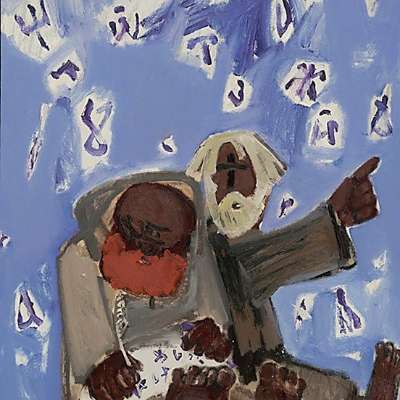Fateyev Vladimir
‘Painting is an individual activity, while theatre is a collective one. Whatever you had thought out, whatever you had drawn – when the actors make a bad performance, when they didn’t manage to enchant the audience, your painted fountains and peacocks won’t help,’ said the artist, ‘but the role that the same fountains and peacocks play in an individual painting depends on the artist only.’ The artist made his case with wonderful paintings that depicted biblical and mythological scenes. He used thick, bright Fauvist colours, though in a very laconic, almost schematic way. Fateev managed to emphasise the pivotal idea of the scene while ignoring all of the excessive details. A wonderful example of such schematic manner is his Chapayev. Fateev said about this work, ‘Chapayev is swimming, you see the diagonal motion. This is how I accomplish the task of the painting – to show that he is sinking in the water’s foam. There is the other diagonal from the left to the right – neither the machine gun, nor the horse can help him. Two diagonals. It seems that it’s not complicated but this is the reason why composition is important.’

What Vladimir Fateev loved in theatre was painting, what he loved in painting was theatre. Perhaps that is why he dedicated nearly all his life to stage design. Born in Krasnoyarsk in 1951, Vladimir graduated from the Vasily Surikov Krasnoyarsk Art College – one of the most prominent art schools in Siberia. Here he met his teacher, Andrey Pozdeev, a well-known graphic artist and painter. After graduating, Fateev moved to Leningrad and enrolled in the Leningrad State Institute of Theatre, Music and Cinematography where he studied art and staging. Completing his studies, he went back to Krasnoyarsk.
Shortly after his return, a new opera theatre opened in Krasnoyarsk where Fateev began his career as a stage designer. At that time, Fateev’s life and work were inextricably linked to theatre. Therefore, when he realized that the local opera theatre did not have the finances to put on quality performances, Fateev moved to Novosibirsk. When the Novosibirsk troupe broke up, he took up easel painting. Nevertheless, he went on travelling around the country, working on set designs until Perestroika. By that time, Fateev had designed more than seventy theatre sets in Krasnoyarsk and many other cities. In his later years, Fateev focused solely on his work for the Novosibirsk Drama Theatre and his independent artistic projects. Vladimir Fateev died on 2 March 2023.





